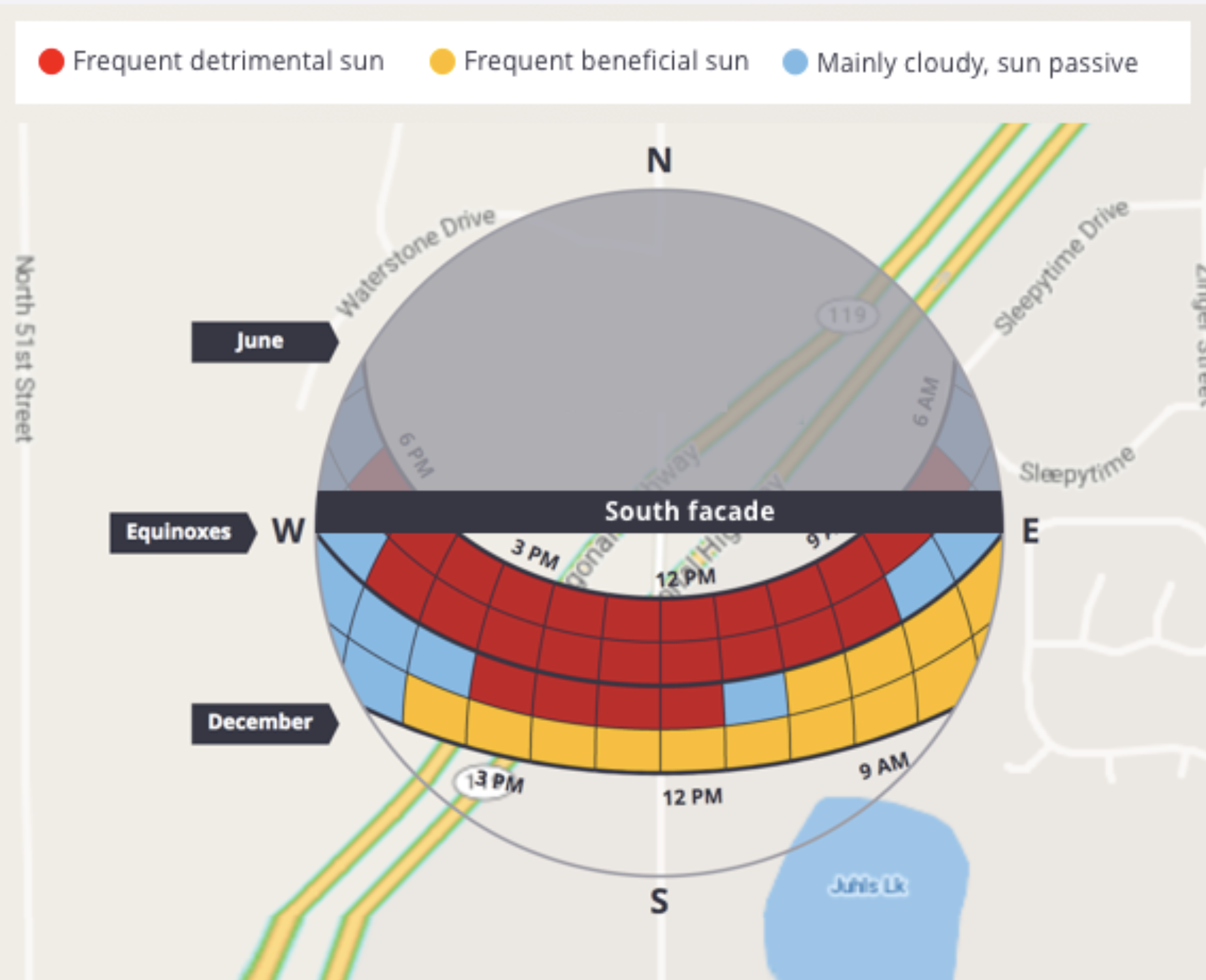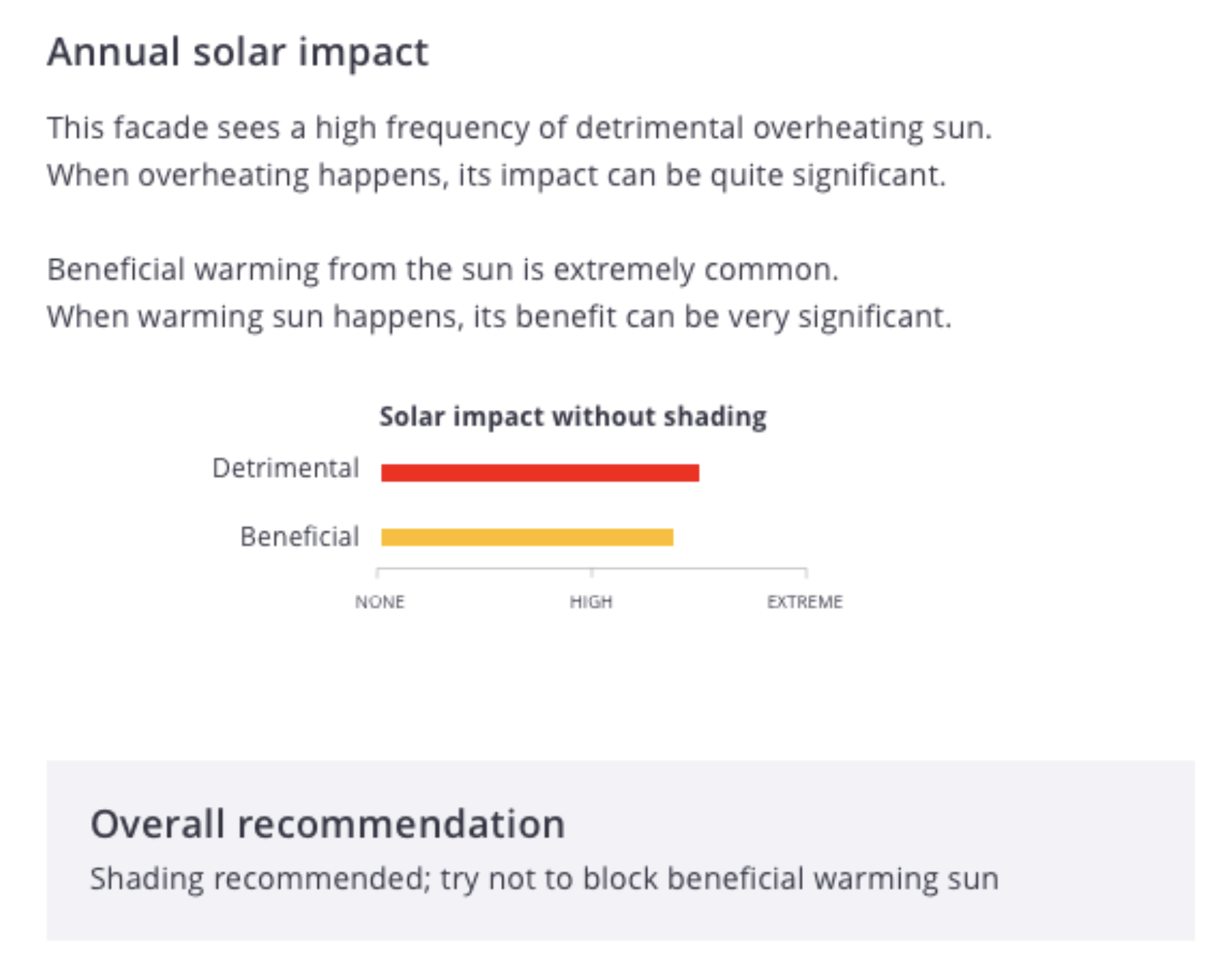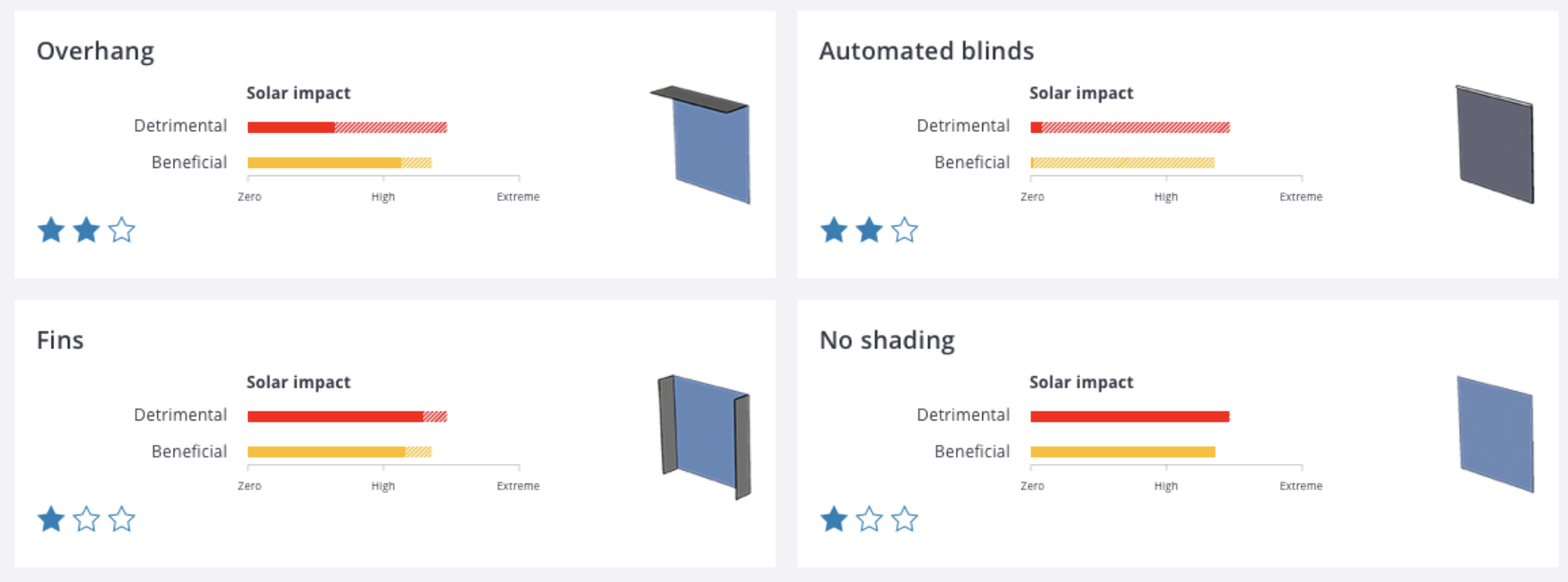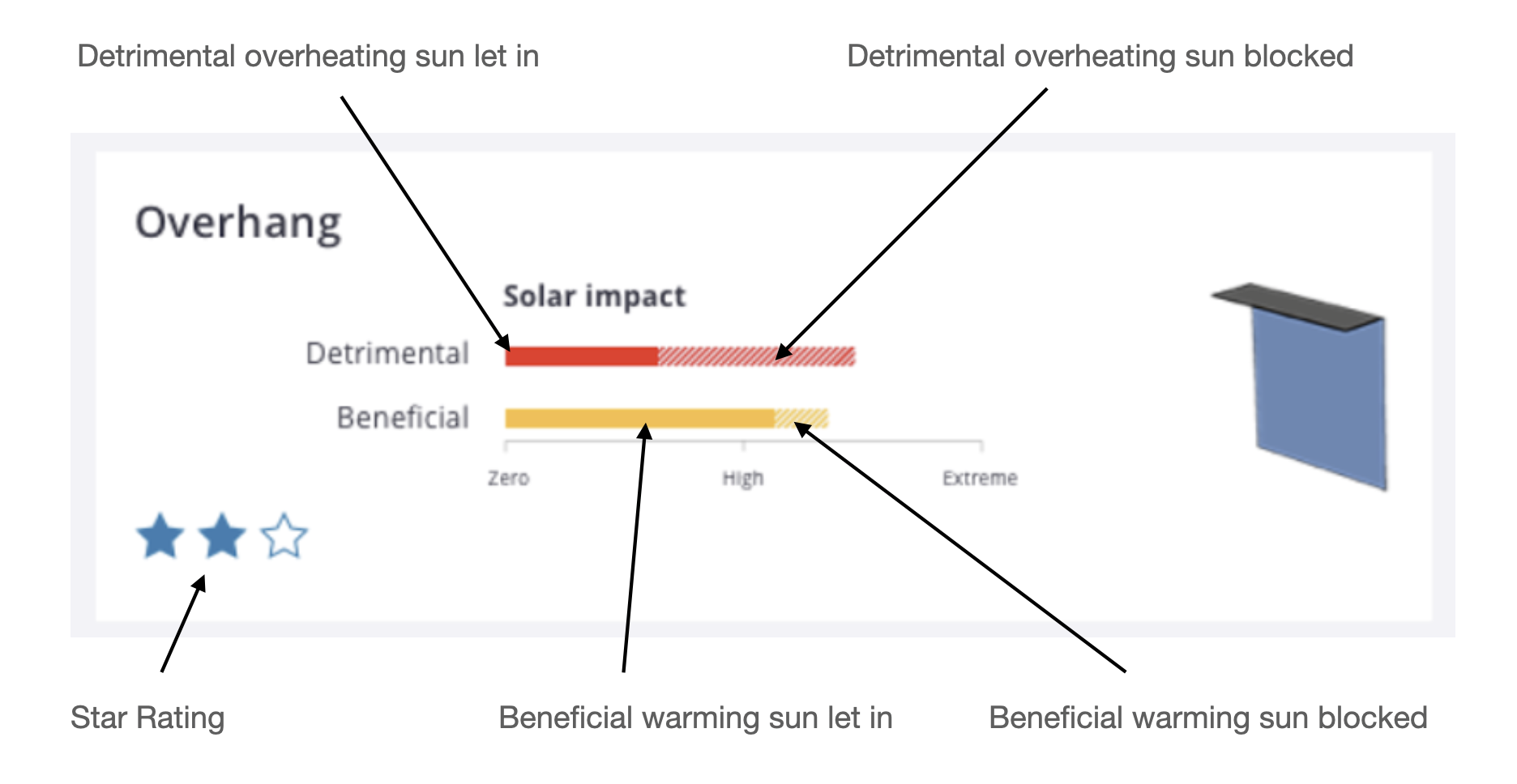Shading - how it’s calculated
This article explains how we generate the results that are displayed in the Shading lens in PreDesign. Specifically it explains:
- Overall philosophy behind the calculation
- Impact of Balance Point Temperatures and Schedules
- How Sun Quality is determined (hourly and for patches)
- How we decide whether to recommend shading for a facade
- How shading options are scored
Related Articles include:
Overall Philosophy
Many SketchUp users employ the shadows feature in SketchUp to understand when parts of a building or site are in sun or in shade. One observed limitation of this process is that shadows assume that it is always sunny and do not offer any insight as to whether the sun’s impact on the building is likely to benefit the building or be detrimental to the building.
The shading feature is therefore based on the idea that information about where the sun is coming from (and the shadows it casts) can be enhanced considerably with a historical assessment of the prevailing conditions at that time, and how those conditions affect different buildings.
To do this, we decided to develop a way to characterise the sun quality at any time to be one of three things:
- Beneficial / warming. This kind of sun is good to let into the building because it adds warmth when warmth is needed. This helps reduce heating energy and makes the building more comfortable although it may still cause glare.
- Detrimental / overheating. This kind of sun is best to block out of a building because it adds more heat when the building is trying to cool down. This kind of sun increases cooling energy, makes the building less comfortable and may lead to bigger HVAC systems.
- Benign / passive. This kind of sun may not be sun at all. The sun may be blocked by clouds and therefore not impacting the building. Alternatively the sun may be coming into a building but it may not be making a difference as a result.
We use these characteristics in different ways within the shading feature to make recommendations about whether shading is needed or not and to assess different shading options.
Balance Point Temperatures and Sun Quality
There is no model uploaded in PreDesign and therefore no known geometry. Instead, we had to determine a way to characterise the sun’s quality without the existence of a building model. To do this we used the notion of Balance Point Temperature (BPT).
Determining appropriate Balance Point Temperatures for different building types
BPT or similar methods are documented in a range of texts. The idea is to derive an ambient temperature outside that is considered to be the condition at which heat gain inside the building equals heat lost to outside.
In other words at the balance point temperature:
internal loads (lights+equipment+occupants) = heat loss through facade (conduction+infiltration)
The balance point temperature varies depending on the assumptions that have been made about a building’s internal loads and facade design. The table below summarises these assumptions and the resulting BTE for each building type.
| Assumption | Residential | Office | School |
| Diversified Occupant Load (W/m2) | 3 | 7 | 8 |
| Diversified Equipment Load (W/m2) | 4 | 10 | 3 |
| Diversified Lighting Load (W/m2) | 3 | 5 | 3 |
| Assembly U-value (Glazing + Opaque) (W/m2/°K) | 1.7 | 1.5 | 1.5 |
| Infiltration Rate (Air Changes / hr) | 0.5 | 0.5 | 0.5 |
| Resulting Balance Point Temperature | 17°C / 62.6°F | 11°C / 55.4°F | 15°C / 59°F |
The determination of BPT is based on an imagined perimeter room depth of 4 m and a wall height of 2.7 m.
Using Balance Point Temperature (BPT) to determine Sun Quality
The BPT is used in combination with the following key hourly values to work out whether the sun is beneficial, warming or overheating:
- Global Radiation (in W/m2, retrieved from the hourly weather file)
- Direct Normal Radiation (in W/m2, retrieved from the hourly weather file)
- Dry Bulb Temperature (in °C, retrieved from the hourly weather file)
Global Radiation represents the heat generated by the skydome as a whole. Direct Normal Radiation represents the heat generated from direct sun. We look at these values together to determine two things:
- When the sun is “passive” (not having an impact)
- Whether the sun is particularly hot and more likely to cause overheating.
The higher these values are, the greater the heat that will be added to the building by exposure to the sun and sky. These values are therefore used to modify down the BPT. For a full reference table of how the BPT is modified, see the end of this article.
For each time step, the modified BPT is compared with the dry bulb temperature outside as follows:
- If the modified BPT is less than the dry bulb temperature outside, then the condition is detrimental/overheating, because it’s hotter outside than you want it to be inside.
- If the modified BPT is higher than the dry bulb temperature outside, then the condition is beneficial/warming, because it’s colder outside than you want it to be inside.
In addition, we work out the “degree hours of overheating sun” and “degree hours of warming sun” for each time step to note the extremity of the effect of overheating or warming when the associated effect occurs. This is done as follows:
Degree hours of Overheating Sun = Outside Temperature - modified BPT - 3
Degree hours of Warming sun = Modified BPT - Outside Temperature + 3
(The modified 3 above is used to allow for a temperature band on either side of the setpoint).
For each situation, the minimum degree hours is zero.
This allows us to characterise each hour as one of passive, detrimental or beneficial and to characterise the extent of detrimental overheating sun and beneficial warming sun when they occur.
Characterising Sun Patches
The sun path diagram used in the shading feature is “simplified” into areas of a common sun position that we refer to as patches. The patches are used to make it easier to visualise the trends in sun quality over the year on a sun path and also easier to visualise the impact of different shading strategies.

The patches shown in the sun path each represent a “Set” of approximately 90 different days (at the same time of the day) where the sun is in approximately the same position in the sky.
These patches are characterised based on the sum of Overheating Degree Hours and Warming Degree Hours for all time steps in the patch as follows:
| Sky Patch Overheating Degree Hours Total | Sky Patch Warming Degree Hours Total (absolute value) | Patch characteristic |
| >500 degC.h | Any | Detrimental Overheating |
| >=200 degC.h, <500 | =< SkyPatch Overheating Degree hours Total | Detrimental Overheating |
| >=200 degC.h, <500 | > SkyPatch Overheating Degree Hours Total | Beneficial Warming |
| <200 degC.h | >=200 degC.h | Beneficial Warming |
| <200 | <200 | Passive |
How Shading Recommendations are made
Although patches are used to help visualise trends over the year on a sun path diagram, the actual recommendations of the need for shading and star ratings for each of the shading options are carried out on an hourly basis.
In the summary view of the shading page, we publish some information including a shading recommendation (example below).

To calculate this, for each time step we do the following:
- Start with the Degree-hours of overheating or warming in that time-step.
- Modify the value based on the angle of incidence of the sun on the facade (time-steps where the sun is behind the facade count as zero).
This results in:
- Total Overheating Degree hours for each typical facade orientation (the sum of each hourly value) over the course of the year.
- Total Warming Degree hours for each typical facade orientation (the sum of each hourly value) over the course of the year.
These two values are communicated on this chart in the summary view.

The scale is fixed, with Extreme being equivalent to 5,000 degree hours and High equivalent to 2,500 degree hours.
An overall shading recommendation looks like this:

The table below summarises how we use these values to make a shading recommendation for each facade:
| Shading Recommendation logic. | Total warming degree hours on the facade | ||
| ≤ 1,000 | > 1,000 | ||
| Total Overheating degree hours on the facade | ≤ 500 | Shading not needed. | Embrace beneficial warming sun; avoid shading. |
| > 500, ≤1000 | Shading benefits limited; use glazing with good solar control. | Embrace beneficial warming sun; avoid shading. | |
| > 1,000, ≤2,000 | Consider shading or glazing with good solar control. | Consider shading; try not to block beneficial warming sun. | |
| > 2,000, ≤4,000 | Shading recommended | Shading recommended; try not to block beneficial warming sun. | |
| > 4,000 | Shading strongly recommended | Shading strongly recommended; try not to block beneficial warming sun. | |
How Shading Options are scored
Shading options are presented in PreDesign as shown below.

For each shading option, at each time step we then
- Identify the % of the glazing that is shaded from the sun at that time step
- Note the resulting Degree hours overheating or warming sun shaded for that time step and the resulting degree hours overheating or warming sun let in for that time step.
This gives us for each shading option:
- Total Overheating Degree hours blocked by the shading option for each typical facade orientation (the sum of each hourly value) over the course of the year.
- Total Overheating Degree hours let in by the shading option for each typical facade orientation (the sum of each hourly value) over the course of the year.
- Total Warming Degree hours lost (ie blocked) for each typical facade orientation (the sum of each hourly value) over the course of the year.
- Total Warming Degree hours let in for each typical facade orientation (the sum of each hourly value) over the course of the year

The star rating for the option is based purely on the amount of overheating and warming sun blocked by the shading device.
final score = overheating degree hours blocked -0.5 ( warming degree hours blocked)
For no shading, the equation is slightly different and based solely on the unshaded amounts:
final score = 2,000- overheating degree hours let in +0.5 ( warming degree hours let in)
Stars are awarded based on the final score as follows:
| Final Score Range | Number of Stars |
| >2,000 degree hrs | 3 |
| >1,000 degree hrs, <= 2,000 degree hrs | 2 |
| >0 degree hrs, <= 1,000 degree hrs | 1 |
| <0 degree hrs | 0 |
References and supporting tables
Balance Point Temperatures
The use of Balance Point Temperatures has been partly borrowed from the following references:
- Heating, Cooling, Lighting. Sustainable Design Methods for Architects. Norbert Lechner. Third Edition, 2009. Wiley.
- Sun Wind and Light. Architectural Design Strategies. 2nd Edition. Brown, GZ & Dekay, Mark. 2000. Wiley.
Balance Point Temperature modifiers and sun quality conditions based on Global and DIrect Normal Radiation
| Global Radiation (Wh.m-2) | Direct Normal Radiation (Wh.m-2) | Balance Point Temperature Modifier from hot sun conditions (°C) | Outside air temperature relative to Modified BPT | Sun quality characteristic for timestep |
| Up to 800 | >0, <80 | 0 | any | Cool Sky |
| 80-250 | 0 | OA >=MBPT | Warming sun | |
| 80-250 | 0 | OA > MBPT | Overheating sun | |
| 250-500 | -2 | OA >=MBPT | Warming sun | |
| 250-500 | -2 | OA > MBPT | Overheating sun | |
| 500-750 | -4 | OA >=MBPT | Warming sun | |
| 500-750 | -4 | OA > MBPT | Overheating sun | |
| Above 750 | -6 | OA >=MBPT | Warming sun | |
| Above 750 | -6 | OA > MBPT | Overheating sun | |
| Above 800 | Any | -6 | OA >=MBPT | Warming sun |
| Any | -6 | OA > MBPT | Overheating sun |